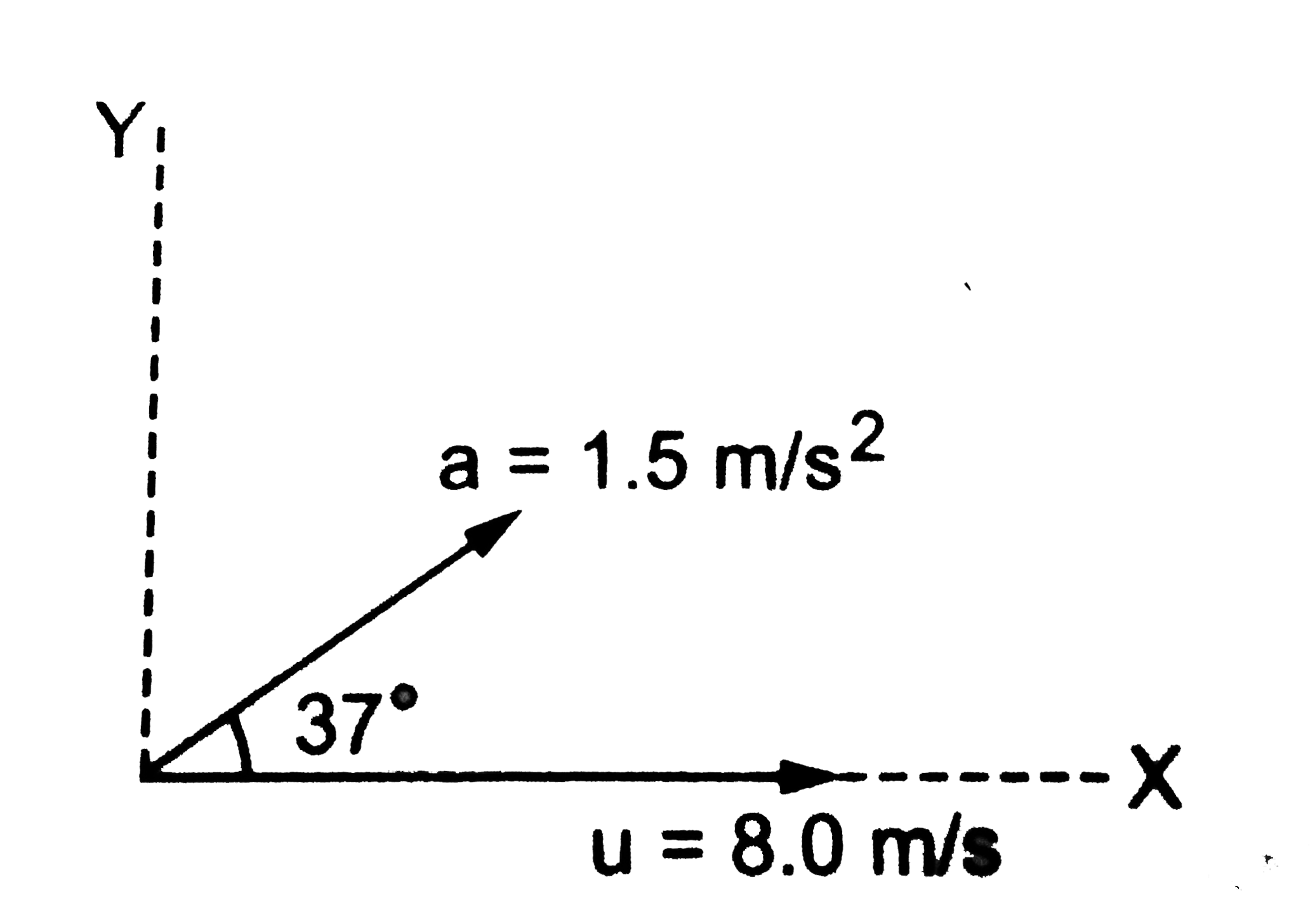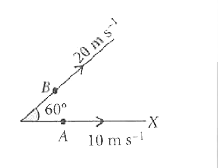a particle is moving in x-y-plane at 2m/s along x-axis. 2 seconds later, its velocity is 4m/s in a direction making 60∘ with positive x-axis. Its average acceleration for the period of motion is:-Solution in Gujrati
√5m/s2, along y-axis
√3m/s2, along y-axis
√5m/s2, along at 60∘ with positive x-axis
3m/s2 at 60∘ with positive x-axis.
The correct Answer is:B
vi=2ˆi
vf=4cos60∘ˆi+4sin60∘ˆj
=42ˆi+4√32ˆi
=2ˆi+2√3ˆj
Δ→v=→vf−→vi=2ˆi+2√3ˆj−2ˆi=2√3ˆj
<<→a>>=2√3ˆj2=√3ˆjm/s2
Topper's Solved these Questions
- KINEMATICSBOOK - ALLEN CHAPTER - KINEMATICSEXERCISE - EXERCISE-02
57 Videos
- KINEMATICSBOOK - ALLEN CHAPTER - KINEMATICSEXERCISE - EXERCISE-03
6 Videos
- KINEMATICSBOOK - ALLEN CHAPTER - KINEMATICSEXERCISE - EXERCISE-2
89 Videos
- ERROR AND MEASUREMENTBOOK - ALLEN CHAPTER - ERROR AND MEASUREMENTEXERCISE - Part-2(Exercise-2)(B)
22 Videos
- KINEMATICS (MOTION ALONG A STRAIGHT LINE AND MOTION IN A PLANE)BOOK - ALLEN CHAPTER - KINEMATICS (MOTION ALONG A STRAIGHT LINE AND MOTION IN A PLANE)EXERCISE - BEGINNER S BOX-7
8 Videos
Similar Questions
A particle is moving in a plane with velocity given by →u=u0ˆi+(aωcosωt)ˆj, where ˆi and ˆj are unit vectors along x and y axes respectively. If particle is at the origin at t=0. Calculate the trajectory of the particle :-
View SolutionThe equation of one dimensional motion of the particle is described in column I. At t=0, particle is at origin and at rest. Match the column I with the statement in Column II.
Column IColumn II(A)x=(3t2+2)m(p)Velocity of particle at t=1s is 8m/s(B)v=8tm/s(q)Particle moves with uniform acceleration(C)a=16t(r)Particle moves with variable acceleration(D)v=6t−3t2(s)Particle will change its direction some time
View SolutionA student performs an experiment to determine how the range of a ball depends on the velocity with which it is projected. The "range" is the distance between the points where the ball lends and from where it was projected, assuming it lands at the same height from which it was projected. It each trial, the student uses the same baseball, and launches it at the same angle. Table shows the experimental results.
∣∣ ∣ ∣ ∣ ∣ ∣∣TrailLaunch speed(m/s)Range(m)110822031.833070.7440122.5∣∣ ∣ ∣ ∣ ∣ ∣∣
Based on this data, the student then hypothesizes that the range, R, depends on the initial speed v0 according to the following equation : R=Cvn0, where C is a constant and n is another constant.
Based on this data, the best guess for the value of n is :-
View SolutionA cube has a side of length 1.2×10−2m. Calculate its volume.
View SolutionA football player kicks a ball at an angle of 30∘ with an initial speed of 20 m/s. Assuming that the ball travels in a vertical plane, calculate (a) the time at which the ball reaches the highest point (b) the maximum height reached (c) the horizontal range of the ball (d) the time for which the ball is in the air, (g=10m/s2)
View SolutionA particle movesin the X-Y plane with a constasnt acceleration of 1.5ms2 in the direction making an angle of 370 with the X-axis.At t=0 the particle is at the orign and its velocity is 8.0 m/s along the X-axis. Find the velocity and the position of the particle at t=4.0 s.

View SolutionAt t=0, the particle is at the origin and its velocity is 10m/s at an angle 37∘ with the x-axis. The particle moves in x−y plane with a constant acceleration of 1m/s2 along the y-axis. Find the magnitude and direction of the velocity after 2s.
View SolutionA particle is moving along a straight line along x-zxis with an initial velocity of 2m/s towards positive x-axis. A constant acceleration of 0.5m/s2 towards negative x-axis starts acting on particle at t=0. Find velocity (in m/s) of particle at t=2s.
View SolutionThe velocity of a particle moving on the x-axis is given by v=x2+x, where x is in m and v in m/s. What is its position (in m) when its acceleration is 30m/s2.
View Solutionएक समतल में गतिमान कण की गति की दिशा X - अक्ष के कोण 30∘ बनती है तथा उसके वेग का Y - अक्ष के अनुदिश घटक 50 मीटर/सेकण्ड है। ज्ञात कीजिए : (i ) कण का वेग
View SolutionParticle A moves along X-axis with a uniform velocity of magnitude 10 m/s. Particle B moves with uniform velocity 20 m/s along a direction making an angle of 60° with the positive direction of X-axis as shown in the figure. The relative velocity of B with respect to that A is

View SolutionA particle: - is moving along the axis. Its initial velocity is 40 m / s (: - along the axis) and acceleration 10 m / s. से^2 (: -Direction of the axis). The particle starts speed from x = 10 m. The velocity of the particle will be zero in seconds
View SolutionA particle: - is moving along the axis. Its initial velocity is 40 m / s (: - along the axis) and acceleration 10 m / s. से^2 (: -Direction of the axis). The particle starts speed from x = 10 m. The maximum x coordinate in the positive direction is
View SolutionA particle: - is moving along the axis. Its initial velocity is 40 m / s (: - along the axis) and acceleration 10 m / s. से^2 (: -Direction of the axis). The particle starts speed from x = 10 m. The velocity of the particle at the point of origin is ... m / s.
View SolutionA particle: - is moving along the axis. Its initial velocity is 40 m / s (: - along the axis) and acceleration 10 m / s. से^2 (: -Direction of the axis). The particle starts speed from x = 10 m. The particle is at the root point in seconds.
View SolutionA particle movesin the X-Y plane with a constasnt acceleration of 1.5ms2 in the direction making an angle of 370 with the X-axis.At t=0 the particle is at the orign and its velocity is 8.0 m/s along the X-axis. Find the velocity and the position of the particle at t=4.0 s.

View Solution
